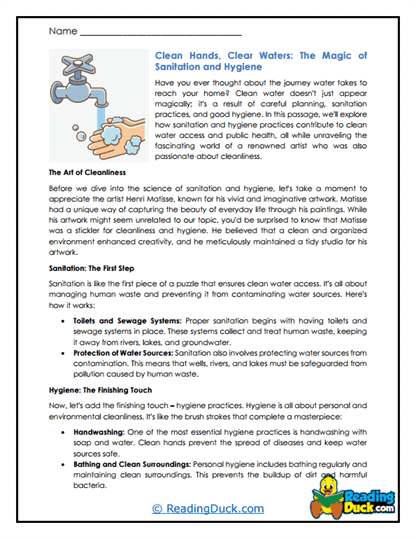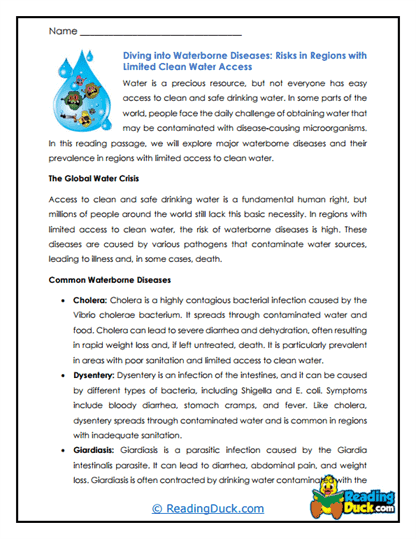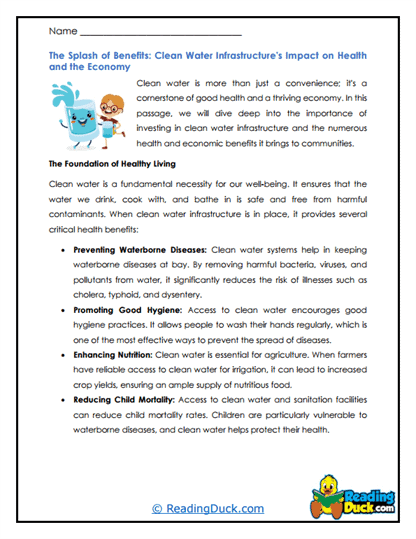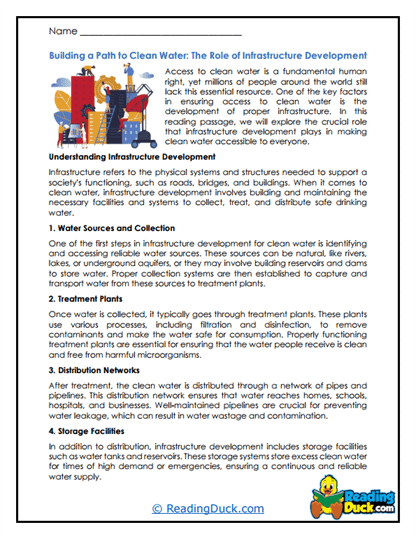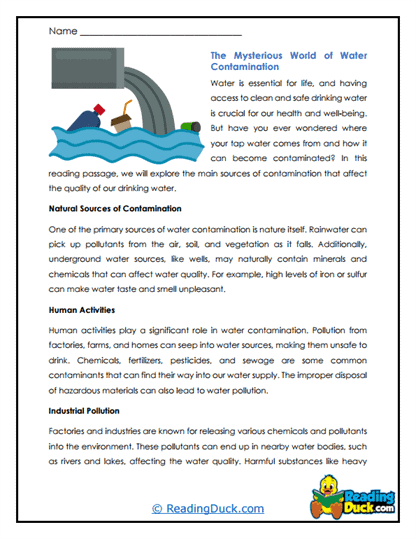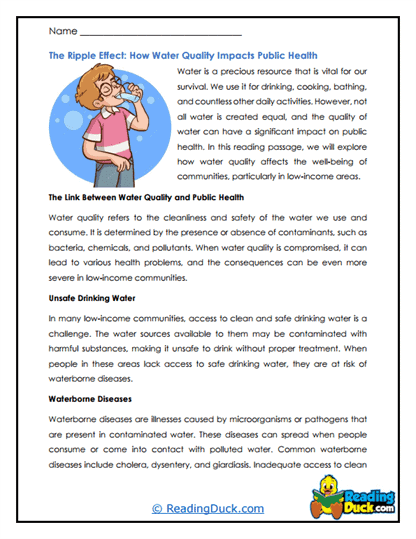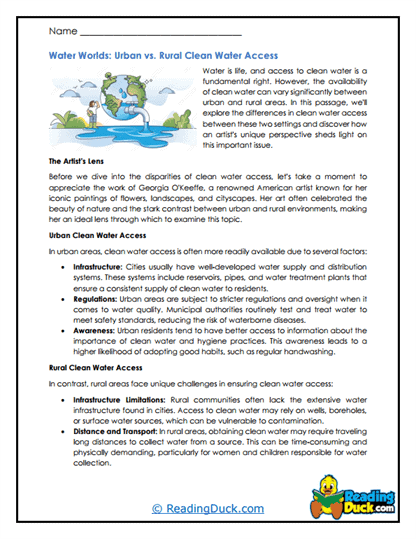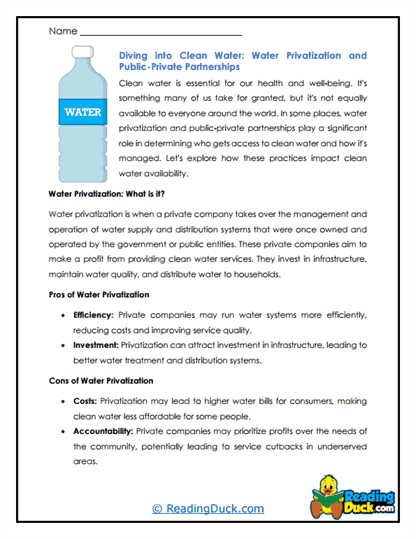Water Scarcity Worksheets
About Our Water Scarcity Worksheets
Our Water Scarcity worksheets provide a comprehensive look into the global issue of water scarcity, a critical topic in today’s world. This collection aims to educate students about the causes, impacts, and potential solutions to water scarcity through engaging and informative content. Each topic within this collection includes several worksheet sets that delve into various aspects of water scarcity, offering students a well-rounded understanding of the challenges and opportunities in addressing this issue.
Each worksheet set includes:
- Multiple Choice Questions: These questions help students reinforce their understanding of key concepts and facts presented in the reading passages, ensuring they grasp the fundamental information.
- Short Answer Questions: These prompts encourage students to articulate their understanding in their own words, fostering deeper comprehension and retention of the material.
- Open-Ended Questions: These questions invite students to express their personal opinions, reflections, and critical thinking on the issues discussed, helping them connect the topic to real-world scenarios and their own lives.
An answer key is provided for every worksheet, making it easy for teachers and parents to guide students through the learning process. All worksheets are available as PDF files, which can be easily viewed, downloaded, and printed for use in various educational settings.
Understanding Water Scarcity: The Challenges and Solutions
Water scarcity is a pressing global issue that affects billions of people around the world. It refers to the lack of sufficient and safe water to meet the needs of communities, industries, and ecosystems. This scarcity is driven by a range of factors, including climate change, population growth, and poor water management practices. Understanding water scarcity is crucial for students as it not only impacts public health and the environment but also has significant social, economic, and political implications.
Key Aspects of Water Scarcity Covered:
- Urban vs. Rural Clean Water Access: Explore the disparities in water access between urban and rural areas, highlighting the challenges faced by underserved communities and the efforts to bridge this gap.
- Universal Access: Understand the global goal of achieving universal access to clean water and sanitation, and the progress and obstacles encountered along the way.
- Success Stories and Strategies for Underserved Regions: Learn about successful initiatives and strategies implemented in various regions to provide clean water to underserved populations, and the lessons that can be applied elsewhere.
- Clean Water Infrastructure's Impact on Health and the Economy: Examine how investments in water infrastructure can improve public health outcomes and stimulate economic growth, emphasizing the importance of sustainable development.
- How Sanitation and Hygiene Keep Us Healthy: Discover the critical role that sanitation and hygiene play in preventing disease and promoting public health, particularly in areas with limited access to clean water.
- How Water Quality Impacts Public Health: Explore the connection between water quality and public health, including the dangers of water contamination and the measures needed to ensure safe drinking water.
- Water Privatization and Public-Private Partnerships: Analyze the debates surrounding water privatization and the role of public-private partnerships in managing water resources, considering both the benefits and potential drawbacks.
- The Role of Infrastructure Development: Understand the importance of developing and maintaining water infrastructure, such as dams, pipelines, and treatment plants, to ensure reliable access to clean water.
- Water Contamination: Learn about the sources and consequences of water contamination, including the impact on ecosystems and human health, and the efforts to prevent and remediate polluted water sources.
- Common Waterborne Diseases: Identify the most common waterborne diseases, their symptoms, and how they can be prevented through proper sanitation, hygiene, and access to clean water.
- The Global Challenge of Access to Clean Water, Sanitation, and Hygiene: Explore the broader challenges of ensuring access to clean water, adequate sanitation, and hygiene (WASH) services, particularly in developing countries and regions affected by conflict.
These topics provide students with a comprehensive understanding of water scarcity, from the root causes to the potential solutions. By studying these aspects, students can appreciate the complexity of the issue and the importance of global cooperation in addressing it.
Why Learning About Water Scarcity Matters
Learning about water scarcity is essential for students of all ages, as it equips them with the knowledge and awareness needed to navigate one of the most critical challenges of our time. Water is fundamental to life, and its scarcity has far-reaching consequences for health, agriculture, industry, and ecosystems. By understanding the factors that contribute to water scarcity and the strategies to mitigate it, students become informed citizens capable of contributing to sustainable solutions.
Studying water scarcity also helps students develop a sense of global responsibility. As they learn about the impacts of water scarcity on different communities around the world, they can better appreciate the interconnectedness of global issues and the need for international collaboration. Moreover, this knowledge fosters empathy and encourages students to consider their own water usage and the broader environmental impact of their actions. By becoming more water-conscious, students can make informed choices that contribute to a more sustainable future.
From Social Studies Classes and Beyond
Water scarcity is a topic that can be effectively integrated into various subjects beyond social studies, offering a multidisciplinary approach to learning. Here are some tips on how teachers and parents can use these worksheets in school or in a homeschool setup:
- Science Integration: Connect the topic of water scarcity with science lessons on the water cycle, ecosystems, and climate change. Discuss how scientific principles relate to the challenges of water management and conservation.
- Geography Lessons: Use the worksheets to explore the geographic distribution of water resources and the impact of climate and topography on water availability. Students can also study how different regions address their unique water challenges.
- Economics and Global Studies: Analyze the economic implications of water scarcity, including its impact on agriculture, industry, and trade. Discuss how global economic systems influence water distribution and access.
- Environmental Education: Incorporate lessons on sustainability and environmental stewardship, focusing on water conservation practices and the importance of protecting water sources from pollution.
- Ethics and Social Justice: Engage students in discussions about the ethical implications of water distribution and access. Explore issues of equity and justice, particularly in relation to marginalized communities that face greater challenges in accessing clean water.
- Language Arts: Use the reading passages in the worksheets as a basis for writing assignments, such as essays, reports, or creative stories that explore the human impact of water scarcity. Encourage students to express their thoughts and reflections on the topic.
- Mathematics: Incorporate data analysis and statistics into lessons on water scarcity, using real-world data on water usage, availability, and distribution. Students can practice graphing, calculating percentages, and interpreting data trends.
- Civic Education: Discuss the role of government and international organizations in addressing water scarcity. Explore how policies and regulations can influence water management and what actions citizens can take to advocate for water security.
- Project-Based Learning: Encourage students to design and implement projects that address water scarcity in their local communities or globally. These projects can include awareness campaigns, conservation initiatives, or fundraising for clean water programs.
By integrating these worksheets into a variety of subjects, educators can create a rich and engaging learning experience that helps students understand the importance of water as a vital resource. These activities not only enhance students' knowledge of water scarcity but also empower them to become proactive in finding solutions to this global challenge.

